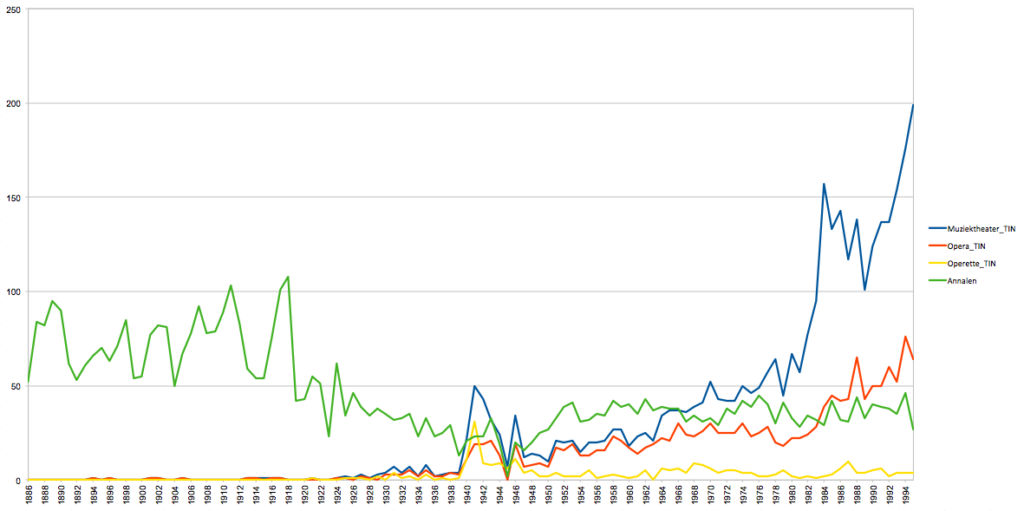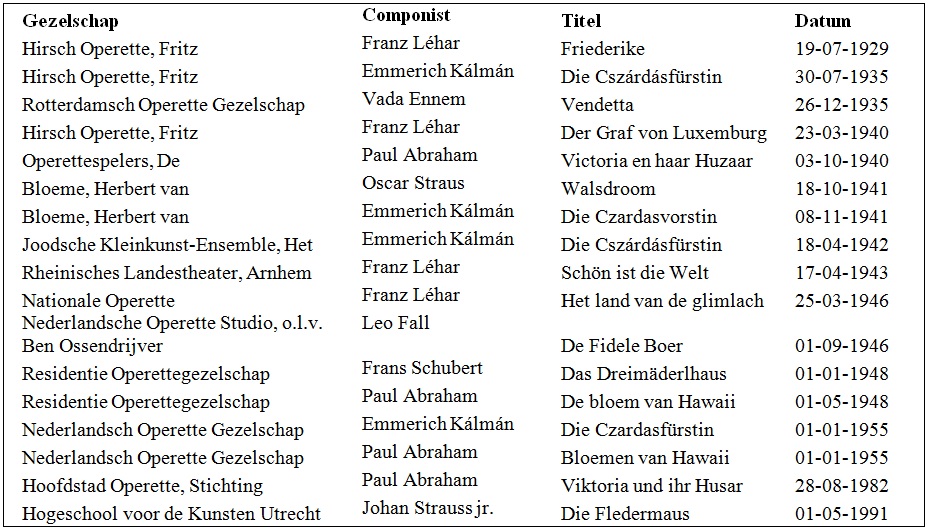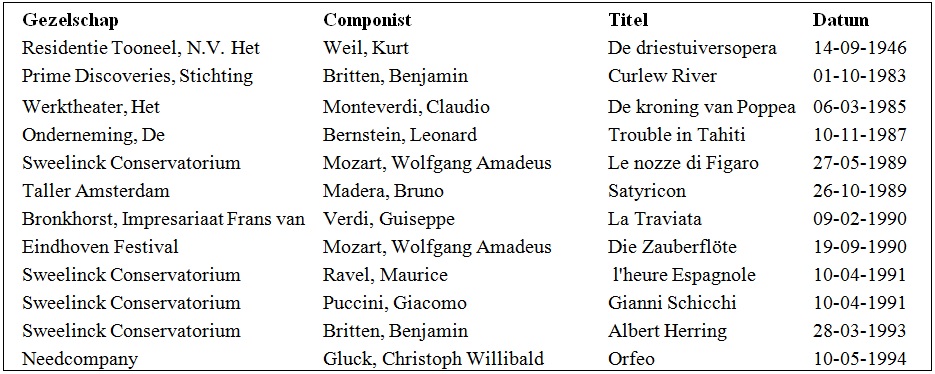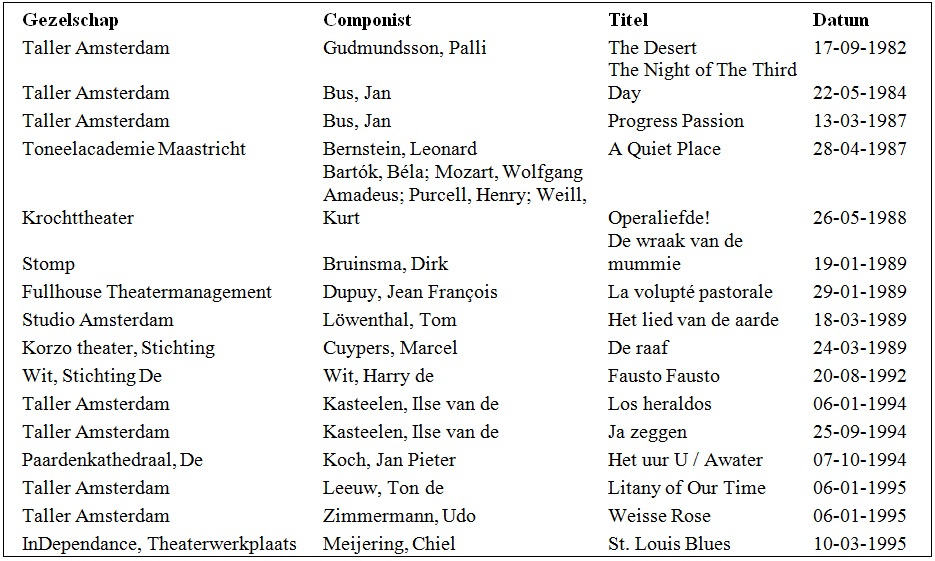By Mascha van Nieuwkerk
”Completomania” afflicts opera history.’[1] With this headline De Volkskrant announced the publication of De Annals van de Nederlandse Opera-gezelschappen in 1996, a fifteen-pound heavy book of almost 1300 pages with over five thousand opera productions in the Netherlands in the years 1886-1995. Published by the Dutch National Opera in collaboration with the Dutch Theatre Institute (TIN), the realization of this ambitious overview of Dutch opera history was controversial. Conflicts about the criteria and the scope of the collection caused insurmountable discord between the main editor, Peter Hulpusch, and the data specialist Piet Hein Honig, provoking Hulpusch as well as the complete advisory committee to withdraw from the project. Now, more than twenty years later, the Annals are finally being digitised and will soon be opened up for critical analysis and additional data input. But since the original publication lacks a proper critical introduction,[2] there is more work to be done than simply digitising the material. In order to be useful as an authoritative source for academic research, users should be properly informed about the origins and systematics of the dataset. In this blog I will attempt to reconstruct and evaluate the choices made by the initial data collectors of the Annals by comparing the data to analogous datasets. What is the scope of the collection and what are its limits? Were the collectors indeed driven by ‘completomania’ and ‘computer fanaticism’ as the initiator Peter Hulpusch insinuated?
From card index to ‘production database’
In order to better understand the backgrounds of this contentious datacollection, let me first briefly introduce the main actors involved in its creation. The project was initiated by the Dutch cartoonist Peter Hulpusch who created a private card index of opera performances during years of private research as a theatre history hobbyist. Hulpusch was stimulated to publish his unique material by professor of musicology Eduard Reeser and Hans Kerkhoff, founder of the ‘saturday Matinee’ at the Amsterdam Concertgebouw. In order to qualify for funding of the Prince Bernard Foundation for Art and Culture they sought collaboration with the Dutch Theatre Institute (TIN). The TIN asked journalist Piet Hein Honig to help Peter Hulpusch with the computational aspects of the project. From the start, the two editors disagreed on basic features of the collection, such as the criteria for data inclusion, the normalization of names and the format for adding metadata. When the Theatre Institute appointed Honig as the editor in chief of the publication, Hulpusch felt his life work was hijacked by ‘computer fanaticism’.[3] It would ultimately lead Hulpusch to withdraw from the project. The complete advisory committee, including Eduard Reeser and Hans Kerkhoff would soon follow his example.[4]
Notwithstanding the tragic personal consequences of this collaboration, the connection with the TIN seems obvious. Hulpusch’ private card index contained the same sort of information as the main database that the TIN curates: a scattered collection of Dutch performing arts activities known as the ‘production database’. Both the Annals and the production database give an index of productions per company per season, with information about the première date, the cast, the artistic team etc.[5] The similarities between the data structure of the two datasets are notable. Both datasets are based on four main lists: companies, works, persons and events. Both datasets only include the first performance of each production per season. The reason for this focus on first performances within the production database is that it originates in the publication of Theatre Yearbooks. With these periodicals the predecessors of the Theatre Institute provided a seasonal overview of all theatre productions staged in the Netherlands and the artists involved in those productions. Published annually starting from 1951, the yearly overviews were used as a sort of ‘phone book’ to keep track of Dutch performing arts companies, their casts and activities and to collect and save details on their productions. Like the analogue publications, the digital archive of the printed yearbooks included only first performances of productions. Later, this archive would evolve into the production database that was enriched with information from archival sources such as performance ephemera.[6] The Annals seems to be based on the same principles as the production database when it comes to the overall data structure and the definition of a ‘production’ as the first performance of a work within a season.
Matching analogous data
Although the production database and the Annals are clearly related, the content of the two datasets is very different. We can use the production database and other analogous datasets as a reference point to analyse the scope of the Annals. Automatically matching the datasets can help us trace the quantitative gaps and qualitative limitations to the data.
The production database is a more extensive dataset than the Annals. It includes activities of all performing arts and not only opera. Although there is a clear overlap between the two datasets, the quantitative differences are striking. If we look at the number of events in both collections there is a big difference in the amount of data collected per season. Figure 1 shows that the Annals collection is especially rich for the period between 1886 and the end of World War I. It is only outnumbered by ‘opera’ events in the TIN collection after 1984. This is noteworthy because Peter Hulpusch initially only wanted to cover a century of opera, starting with establishment of the first Dutch opera company in 1886 and ending with the opening of Het Muziektheater in 1986. Indeed, there has been a proliferation of small opera companies, producers and small foundations since the 1980s. The editors of the Annals do not seem to have included all those small initiatives. Small, hybrid companies such as the Needcompagny, Taller Amsterdam and Theaterwerkplaats InDependence are not included in the Annals.
For the early period, however, the Annals is more comprehensive in covering Dutch opera activity than the production database. Whereas the production database has almost no première dates up until World War II, between 50 and 100 productions each season are indexed in de Annals between 1886 and 1924. Given the fact that these dates are only the first stagings of every production, the total number of opera performances must have been at least a factor ten more. In this period the number of replays depended on the popularity of the production. Some popular opera’s were repeated during the whole season. For example the Dutch translation of Gounod’s Faust that was premiered in 1886 by Het Hollandsch Opera-Gezelschap was performed 48 times.[7] Apart from some exceptionally popular operas like Faust, an average opera had five to fifteen performances per season.[8] This means that according to the Annals there would have been an average of between 500 and 1000 opera performances in the Netherlands each season in this period. This is just a rough estimate, but quite a good result for a country that has often been described as ‘non-operatic’. Indeed, S.A.M. Bottenheim rightfully states in his overview of Dutch opera history that the Netherlands might not have been an important centre of opera production but it was a vibrant market for its reproduction. ‘Wat boven alles kan worden vastgesteld is de levendige belangstelling van zeer velen uit alle lagen der bevolking, zoodat de opera-kunst ook te onzent misschien nog meer volkskunst is geweest dan eenige andere uiting op het omvangrijke terrein der muziek’[9]
Figure 1: Number of events in the Annals, compared to the events in the production database with the general tag ‘muziektheater’ and the secondary tags ‘opera’ and ‘operette’.
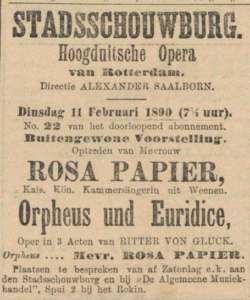 To check the coverage of the Annals in more detail, we can use samples of analogous datasets that are more specialised than the production database, covering the repertoire of one venue or company. For example, a research team at CREATE is now working on a database with the complete repertoire of the City Theatre of Amsterdam ACT: Amsterdam City Theatre Database. When it comes to opera repertoire staged in the City Theatre these data should be analogous to the productions indexed in the Annals. Unfortunately the ACT database is not jet complete for the whole period, but a sample of the years 1886-1890 can be matched almost exactly to the Annals.[10] All opera works can be related to a production in the Annals, except for two instances: special performances in de City Theatre celebrating famous singers Rosa Papier and Sigrid Arnoldson in Orpheus und Euridice by Gluck and Le Pardon the Ploermel by Meyerbeer cannot be found in the Annals. In the digitised version we will add these works to the repertoire of the German and the French Opera Companies for the years 1889 and 1890.
To check the coverage of the Annals in more detail, we can use samples of analogous datasets that are more specialised than the production database, covering the repertoire of one venue or company. For example, a research team at CREATE is now working on a database with the complete repertoire of the City Theatre of Amsterdam ACT: Amsterdam City Theatre Database. When it comes to opera repertoire staged in the City Theatre these data should be analogous to the productions indexed in the Annals. Unfortunately the ACT database is not jet complete for the whole period, but a sample of the years 1886-1890 can be matched almost exactly to the Annals.[10] All opera works can be related to a production in the Annals, except for two instances: special performances in de City Theatre celebrating famous singers Rosa Papier and Sigrid Arnoldson in Orpheus und Euridice by Gluck and Le Pardon the Ploermel by Meyerbeer cannot be found in the Annals. In the digitised version we will add these works to the repertoire of the German and the French Opera Companies for the years 1889 and 1890.
Besides archives of venues such as the City Theatre, multiple opera companies kept track of their own repertoire. For example, in the appendix of the publication Een Noodzakelijke Luxe: 15 jaar Nederlandse Operastichting 1971-1986 there is a list of repertoire performed by the Dutch Opera Foundation per season for this period.[11] A comparison with this index gives a more diffuse image of what is covered by both sources. I have listed the productions that are missing in both indices in diagram 2.
Figure 2: Missing productions of the Dutch Opera Foundation in the Annals and the overview published by the Foundation itself.
Where does ‘opera’ end?
The above comparisons indicate the extent to which the Annals cover the available sources. But completeness is a precarious issue when it comes to data collections. Indeed every data collection can only be complete within the limits set to it by its collectors. Since the Annals are a collection of opera performances the index only includes those events that can be identified as ‘opera’. But where does ‘opera’ begin? And where does it end?
The entry ‘opera’ in the New Grove Dictionary of Music and Musicians directs to a terminological minefield of definitions. As Tim Carter rightfully observes in his chapter ‘What is Opera?’ in the Oxford Handbook of Opera, defining opera insurmountably leads to an impossible choice between narrow definitions that exclude to many and generic definitions that exclude to few.[12] Many examples of ‘a drama in which the actors sing some or all of their parts’ – such as ‘musical’ and ‘operetta’ pieces – are likely to provoke a heated discussion among operatic gatekeepers.[13] Given these precarious considerations it is not surprising that the authors of the Annals did not explicitly discuss their definitions in their introduction.
But like every data collector Hulpusch and Honig did inevitably define their subject, implicitly, by setting limits to their data collection. We can reconstruct the borderlines they set by, again, comparing the Annals with the much broader production database. To begin with, the most indefinite border to ‘opera’ is that to the land of ‘operetta’. The editors of the Annals undoubtedly had to deal with the ‘operetta problem’ since opera companies in the Netherlands often performed popular operettas. According to the newspaper article that announced the Annals, Hulpusch and Honig did not agree on whether to include these operetta productions or not. When Hulpusch insisted on including them, Honig – the ‘completomanic’ – demanded that other similar operetta productions should be added in return.[14] We do not know the details of this negotiation but we can analyse its outcome. If we look at the overall inclusion of operettas in the Annals it appears that the collectors decided to let the companies and not the works be leading. As a starting point, the index includes activities of companies that were explicitly dedicated to the production of opera works. Of those companies all productions found by the collectors are entered in the index, including works that could be theoretically defined as operettas, such as Die Fledermaus by Johan Strauss jr. and Das Land des Lächelns by Franz Lehár. On the other hand, the activities of companies specialised solely in operettas are not included. This means that some clear instances of operettas can be found in the index – performed by opera companies – that are not included when performed by operetta companies. In figure 2 I have listed some examples of productions of operetta companies that can be found in the production database but are not included in the Annals. Interestingly enough, the mentioned works are included in the Annals when performed by actual opera companies.
Figure 3: Examples of productions of operetta companies who are not included in the Annals, though the mentioned works are included when performed by actual opera companies.
On the other side of the opera land there is an even more complex border area of hybrid performances balancing between opera and theatre and between opera and concert practice. Throughout Dutch opera history there have been multiple manifestations of these hybrids. For example, the tradition of concert performances of operas in concert halls, or the performances of plays with incidental music in the City Theatre in the nineteenth century.[15] In fact, the production database contains many hybrid forms such as puppet opera, opera ballet, rock opera, Chinese opera, and other variants of music theatre that are labelled as ‘opera’. These label-crossing forms are not included in the Annals. Clearly, the definition of opera used by the curators of the production database is much broader than the definition used in the Annals. Especially for the period after 1980, when small companies often specialised in new, innovative forms of music theatre, the production database outnumbers the Annals in the amount of productions tagged as ‘opera’. In figure 4 I have listed examples of small innovative music theatre productions that are tagged as ‘opera’ in the production database but are not included in the Annals. Furthermore there are some instances of opera productions from the production database that cannot be found in the Annals although the works involved are included elsewhere.
Figure 4: Examples of productions from the production database that are not included in the Annals, though the works are included elsewhere in the opera dataset.
Figure 5: Examples of productions by small innovative music theatre companies that tagged as opera in the production database but are not included in the Annals.
Conclusion
The Annals of the Opera Companies in the Netherlands is an extremely rich source. If we look at the available analogous data the extensive scope of the index is evident. It seems as if the alleged ‘completomania’ has paid off. But, inevitably, the dataset is a selection of works, productions and companies. And as is the case in many examples of lexicons and annals, the selection is based on rather vague and subjective criteria. The famous Annals of Opera by Alfred Loewenberg, for example, only includes ‘those [operas] that have obtained success or attracted attention outside their countries of origin.’ In fact, Loewenberg states that ‘the number of entries could easily have doubled; but the book had to be kept within reasonable limits.’ The authors of the Annals of the Opera Companies in the Netherlands have chosen not to articulate their criteria in their introduction but I have shown in this blog that the choices made in the collecting process can partly be reconstructed by comparing analogous datasets. In the end, the collectors did draw a line between what is opera and what is not. This line, sometimes dashed, sometimes bold, gives a beautiful insight into the historical dynamics of the opera genre.
[1] Roland de Beer, ‘“Compleetheidswaanzin” teistert historie opera’ in: De Volkskrant, 19 januari 1996.
[2] Peter Hulpusch and Piet Hein Honig, Annalen van de operagezelschappen in Nederland 1886 tot 1995 (Amsterdam 1996) i-ii.
[3] De Beer, ‘“Compleetheidswaanzin”’.
[4] Kaspar Jansen, ‘Een opsomming van 1,7 kilo. Annals van de operagezelschappen in Nederland’ in: NRC Handelsblad, 16 februari 1996.
[5] http://theatercollectie.uva.nl [27 februari 2018)
[6] Floortje Bakkeren, ‘Productiedatabase’ (internal memo of the Dutch Theatre Institute and UvA Special Collections), 20 december 2017.
[7] S.A.M. Bottenheim, De Opera in Nederland (Amsterdam 1946) 196.
[8] A sample of newspaper announcements of opera performances in the period shows that an average opera production had between five and fifteen performances per season. Algemeen Handelsblad, 1886-1890.
[9] Bottenheim, De Opera in Nederland, 9.
[11] Tim Coleman ed., Een noodzakelijke luxe: 15 jaar Nederlandse Operastichting 1971-1986 (Zutphen 1986).
[12] Tim Carter, ‘What is Opera?’ in: Oxford handbook of Opera (Oxford 2014) 15-32, 15.
[13] Carolyn Abbate and Roger Parker, A History of Opera. The last Four Hundred years (London 2015) 17.
[14] Roland de Beer, ‘Compleetheidswaanzin’, 19 januari 1996.
[15] These performances were advertised as ‘klucht met zang’. ACT: Amsterdam City Theatre Database.
 Mascha van Nieuwkerk studied violoncello at the Conservatory of Amsterdam (2016) and completed a MA in History at the University of Amsterdam (2016). She is currently working as a Pre-PhD fellow in Music History for The Dutch Opera Context Project. An award winning cellist, Mascha is a founding member of the ensemble Fuse, well know for their label-crossing arrangements and re-compositions of classical, jazz, and folk pieces for the Dutch Classical Music TV-show Podium Witteman.
Mascha van Nieuwkerk studied violoncello at the Conservatory of Amsterdam (2016) and completed a MA in History at the University of Amsterdam (2016). She is currently working as a Pre-PhD fellow in Music History for The Dutch Opera Context Project. An award winning cellist, Mascha is a founding member of the ensemble Fuse, well know for their label-crossing arrangements and re-compositions of classical, jazz, and folk pieces for the Dutch Classical Music TV-show Podium Witteman.

